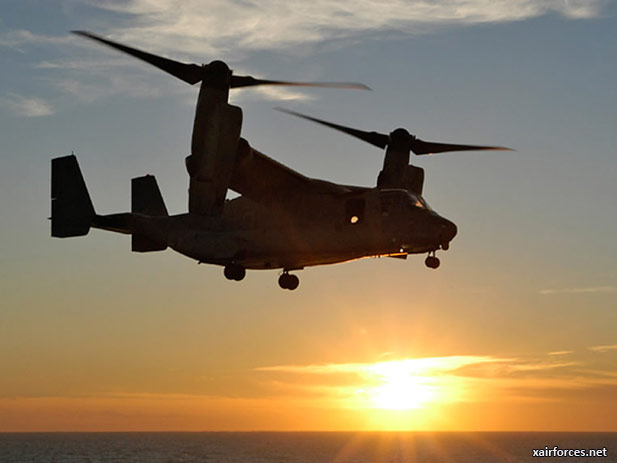
US offers Israel new $3b air weapons systems deal

The package, which includes F-35 stealth fighter bombers, V-22 Ospreys and KC-135 air refueling tankers, will enable Israel to strike longer range targets.
A new defense deal between the US and Israel, after a year of secret negotiations, will give the Israel Air Force (IAF) a technological overhaul. The IAF will receive F-35 Lightning II stealth fighter bombers, the latest C-130J Hercules transports and cargo planes, both made by Lockheed Martin Corporation (NYSE: LMT), and the Italian M-346 jet trainer, made by Alenia Aermacchi. The IAF will also receive the new Boeing KC-135 air-to-air refueling tankers, which it has only been able to dream about until now. These planes will greatly extend the range of operations of Israeli combat pilots.
The IAF will also receive the V-22 Osprey tiltrotor aircraft, a unique aerial platform, which until now has only been in operation with the US Air Force.
Details of the deal, which will be financed by US military aid, were revealed on Friday, ahead of today's arrival in Israel by US Secretary of Defense Chuck Hagel for his first official visit. During his visit, he will meet Minister of Defense Moshe Ya'alon to discuss implementation of the deal and other security matters, including Iran's nuclear program and the situation in Syria.
The new $3 billion US-Israel defense deal is part of $10 billion in arms sales to countries the Middle East. Israel will receive the latest and most sophisticated arms under these deals in order to maintain its qualitative edge in the region. The wider deal includes the sale of F-16s and precision long-range to the United Arab Emirates, and specially adapted precision missiles to Saudi Arabia for its air force.
Cutting edge radar and the latest missiles
In addition to the KC-135 and V-22 that Washington is offering Jerusalem, the deal will include cutting-edge radars and the latest missiles, which should interest the IDF and improve its offensive capability. These are guided missiles for targeting radar systems to quickly provide a large operational area for attacking well-defended targets. A good example of this is a scenario of an attack against Iran's nuclear facilities.
Realization of the new deal will be great news for Boeing, which some years ago proposed equipping the IAF with V-22 aircraft, insisting that it fitted its operational needs like a glove. The helmets used by the pilots of the V-22are produced by Israel's Elbit Systems Ltd. (Nasdaq: ESLT; TASE: ESLT). The V-22 can carry a payload similar to the IAF's Saar, Yasur and Blackhawk helicopters.
Just like a helicopter the V-22 can take off and land vertically due to its pair of tilted rotors. When the aircraft reaches the required altitude, and starts on its flight path, the propellers tilt to a horizontal angle enabling the aircraft to fly at higher speed than a helicopter like a regular plane. The IAF have tested out the plane/helicopter with several pilots sent to the US to experience flights and check out the performance of the strange hybrid that has to date only served the US special military forces. The Israeli pilots like what they saw. The obstacle to bringing it to Israel has been money with each V-22 costing $70 million with the helicopter/plane until now left out of the basket of US aid to Israel.
During his frequent visits to Washington over the past 18 months, former Defense Minister Ehud Barak pressed for V-22s to be provided to Israel in order to maintain the IAF's qualitative advantage in the Middle East with the US extensively selling other advanced equipment in the region. IDF Chief of Staff Lt. Gen Benny Gantz also pushed for six to eight V-22s during his visit to Washington in February.
The V-22 can carry up to 24 combat soldiers, can land or take off from naval carriers, and refuel in mid-air.
In the latest deal the US has also lifted its veto on the sale of KC-135 air-to-air refueling tankers that the IAF has sought for many years. This is the main refuel aircraft serving the US Air Force and significantly extends the range of potential operations. The aircraft is based on the Boeing 707 but in contrast to those aircraft that the IAF has reconfigured as refueling tankers, the KC-135 has been designed from the outset as a flying fuel tanker.
The strenuous US opposition to date to supplying these refueling aircraft to Israel has stemmed from concerns by some in the White House that the new plane would boost the self-confidence of Israeli leaders and could lead them to attack Iran.
New opportunity
Israel's defense established was hard pressed today to assess how the new deal to be equipped with the stealth bombers, refuel tanker aircraft and helicopter/planes will be completed. Even if the deal is meant to be funded by US aid, existing plans already account for every dollar of that aid. Over the past year US aid amounted to $3.1 billion and aid includes an injection of $250 million for continued equipment for new Iron Dome short range missile defense systems.
With removal of the White House's opposition to supplying Israel with the new weapons, the Defense Ministry will need to think about how to realize the new opportunity. So far not a single stealth aircraft has landed in Israel but at Defense Ministry headquarters, they are talking about a second deal to buy stealth aircraft that would cost billions. Possibly payments could be spread over a very long period allowing Israel to also finance an arsenal that includes the V-22s, flying fuel-tankers and advance radar that would enable it to bomb distant targets wherever.
Source: By Yuval Azulai. globes.co.il News - 22 April 2013
Photo: The Israeli Air Force V-22 Osprey Tiltrotor Aircraft (Photo by aviationintel.com)
(22.04.2013)
|